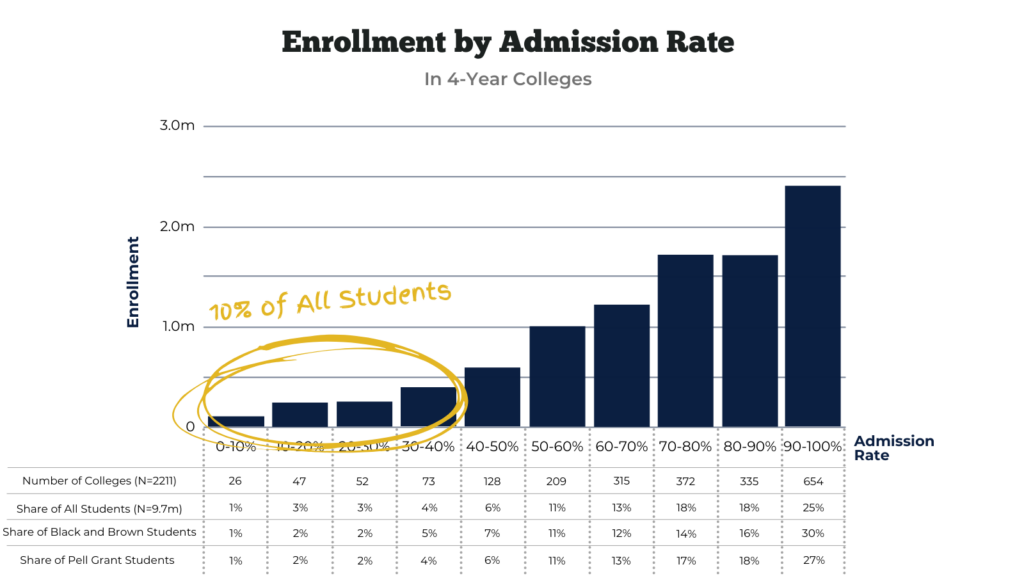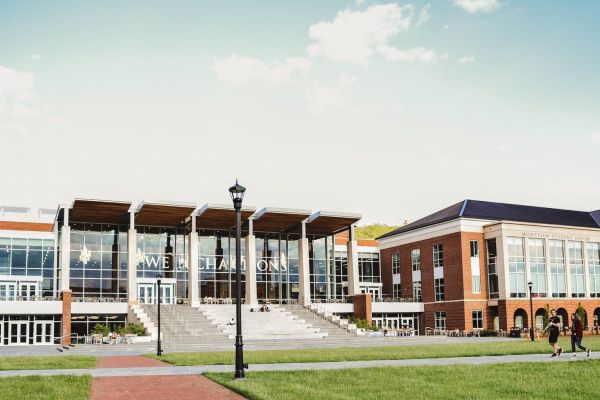The Irrelevance of Highly Selective Colleges
Below is an amazing chart on college selectivity. It groups 4-year colleges into 10 buckets by how selective they are, and it shows how many students (of various backgrounds) are in each bucket of college selectivity.
Take a close look. What do you see? Below, I give you my 5 take-aways.

1: Highly Selective Colleges = Irrelevant
It’s just math. See the left side of the chart.
Notice that only 10% of 4-year college students in the US attend highly selective colleges with admission rates below 40%. The other 90% of 4-year college students go to modestly selective or non-selective colleges.
And if you went to an “Ivies Plus” college – that is, an Ivy League college or a similarly exclusive college like Stanford, University of Chicago, Williams, and so on — then note that you are represented in the far-left column. That’s the column with 26 colleges that have admission rates < 10% and that educate 1% of 4-year college students.
2: Current Plans in Highly Selective Colleges = Continued Irrelevance
Highly selective colleges often ponder some mix of the following:
- Building more dormitories, hiring more faculty, and so on to expand their on-campus capacity.
- Ending legacy admissions to enroll a more meritocratically selected student body.
- Further lowering their prices and modifying their admissions policies to enable attendance by more low-income students and students of color (who, it must be said, typically benefit immensely when they get a scarce spot at a selective college).
None of these changes by top-rated colleges — laudable as they are — will make them any less irrelevant. They will remain tiny.
Tiny – no matter how you slice and dice it — is irrelevant.
3: Most Top Students are NOT in Highly Selective Colleges
This is also just math.
Most talented, high-potential, and generally amazing students – pick any definition of these adjectives – are in the middle or on the right side of the above chart, in modestly selective or non-selective colleges.
Where else could they be?
There aren’t enough dormitory rooms on the left side of the chart to sleep but a few of them.
4: Point 3 (above) Needs Airtime
That modestly selective and non-selective schools hold most of the amazing college students is rarely emphasized by the press, by employers, or by selective colleges themselves.
And it should be, for at least the following reasons:
- It shows appropriate respect for students who do not go to highly selective colleges.
- It encourages employers to look in all the right places (not just the highly selective places) for new hires.
- It focuses public policy and public conversation on improving modestly selective and non-selective colleges which suffer from low graduation rates, uneven employment outcomes, and high prices.
5: Relevance for Highly Selective Colleges = Online Degrees
If highly selective colleges want to be relevant to the larger college crisis in the US, then they need to issue more degrees. A lot more degrees.
The only way they can do that, as far as I can tell, is to start branded online degree platforms.
I will have more to say about this idea – about the prospect of top-rated and highly selective colleges issuing branded, affordable, and widely accessible online degrees – in future posts.
For now, I will just admit that I like that idea a lot, if it pursued carefully and within constraints. I think that it can be done in degree fields (like computer programming and accounting) with highly explicit knowledge and skills, and I think it would be beneficial for the brands of elite colleges if they served more students and different types of students. And I think it would productively disrupt the college sector.
More on this topic down the road.

